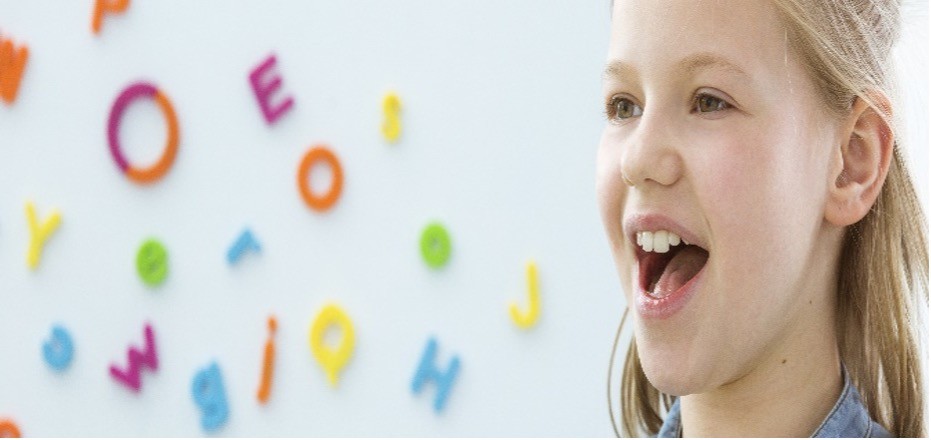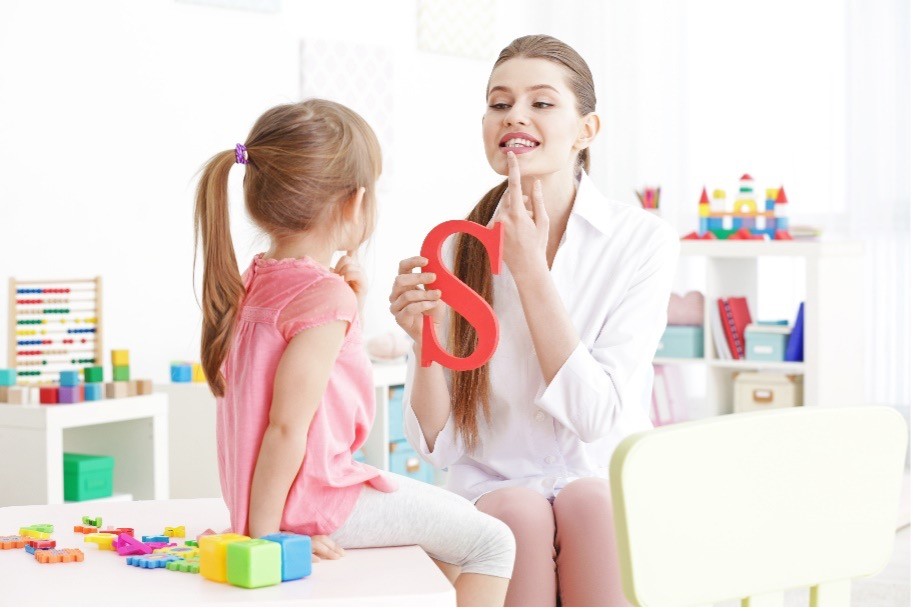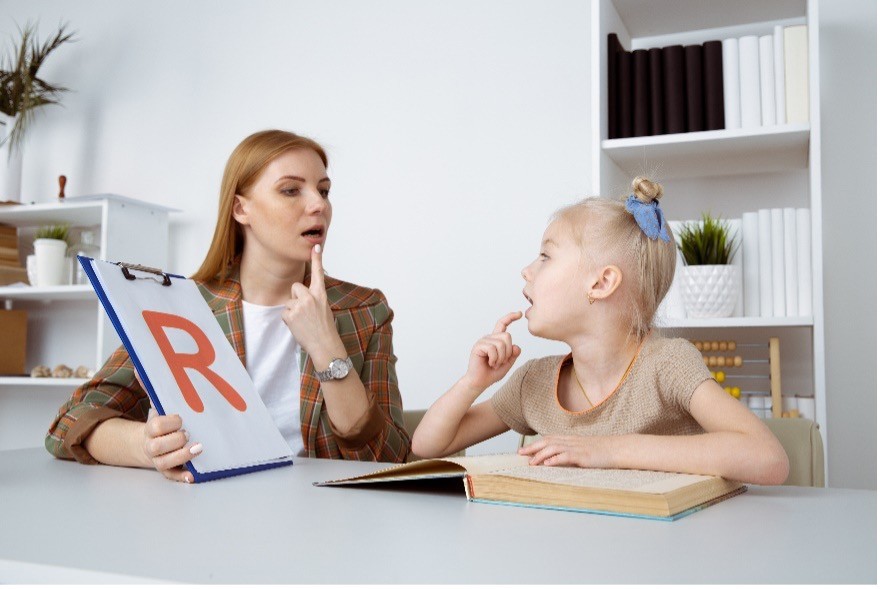This is Speech Sounds Development Chart – see if your child has speech sound delay.
If they are having trouble producing any of the sounds in the age bracket – try the tips provided below. I have put together some tips for you to try and help your child with single sound production.
Comment and let me know if you’ve found the tips helpful or if you require further tips.
| Age expected | |||||||
| 2 Years | p | b | m | t | d | n | w |
| 3 ½ Years | k | g | y | f | s | h | |
| 4 ½ Years | v | z | sh | ch | j | l | |
| 6 Years | R* | Th* |
Development of Speech Sounds
/p/
For /p/, use the following cues. P is a quiet sound. Tell your child to whisper the sound f they make the /p/ sound the same as the /b/ sound – say, this a quiet sound – we need to whisper it – Watch My Mouth (this will help them to see what your lips are doing)
- Put your lips together
- Make your lips pop
- Switch the voice off! (quiet sound)
- Help your child close their lips together with their fingers, if they are having difficulty doing that – model this in the mirror
/b/
To produce the /b/ sound, use the following cues with your child.
- Watch My Mouth (this will help them to see what your lips are doing)
- Put your lips together
- Make your lips pop
- Switch the voice on! (loud sound)
- Model in front of the mirror.
/m/
The /m/ sound is produced by pushing the lips together and humming. Ask and show your child how to close their lips closed and then ask them to hum or turn their voice on. The mouth should not open at all while making this sound, all of the air should come through the nose.
/t/
To produce the /t/ sound, have your child tap their tongue right behind their top, front teeth. If your child is having trouble figuring out where to put their tongue, use these techniques to show them the right place: Touch the spot right behind the top, front teeth with a popsicle stick. Then tell them to put their tongue in the same spot.
- Put a sticky food, like peanut butter or jam, on the spot right behind their top, front teeth. Then, have them lick it off. When you are describing that spot again, call it the sticky spot.
You can try this in front of the mirror so that they can see what you are doing and also try and show them with your tongue!
/d/
To produce the /d/ sound, you can use the same cues as the /t/ sound, but your child will need to turn voice on. Tell them this is the loud sound.
/n/
To produce the /n/ sound, tell your child/show them to put their tongue in the same position as the /t/ sound (see the cues mentioned for /t/). However, this time, the child will need to hold the tongue in that position while they hum. If the child is having trouble switching the voice on then ask/model humming a song as they hold their tongue in that position.
/w/
To produce the /w/ sound, tell your child to begin by saying “oo” (like the sound of a ghost!) as in “boo” and then slowly open the lips apart to say “uh”. It should sound like “oooouuh”.

/k/
Producing the /k/ sound, the child needs to get their tongue right to the back of the mouth. If your child has difficulty finding the right place for their tongue, use some of the following strategies:
- Get a small lolly/ popsicle stick. Place it gently on the child’s tongue and hold down the front of the tongue so that it can’t lift/rise up to be in position for the “t” sound. You can try to push the tongue back towards the back of the throat slightly with the stick. It might be helpful do this in front of a mirror and also show the child how it looks on your tongue to show that it is not going to hurt them.
- Ask your child to lay on their back while saying this sound. Gravity will hopefully help them drop their tongue back. Again, you lay next to your child and model how to say the sound – mouth open, the sound comes from the back of the mouth rather than the front.
- Use your thumb to gently push up and back on the soft spot on the bottom of your child’s chin. This might get the tongue back to the right position.
/g/
The /g/ sound is produced in the same space mouth space as the /k/ but with the voice turned on as this is known as a loud sound.
The /h/ sound is produced by making puffs of air at the back of the mouth. Have your child pretend to pant like a dog to make this sound.
Play ready steady go game….ready, steady (make sure have your child’s eye contact and say, g,g,g,g,gooo
Make it fun and not work – hopefully, this way you can work on the sound production without ‘working’ on the sound!
/y/
For the production of the “y” sound, tell/show your child to begin by saying “ee” like in “see” and then slowly open the mouth to say “uh”. It should sound like “eeeeeuuuhh”.
/f/
Use these cues to get your child to say the /f/ sound:
- Bite your bottom lip (use a mirror to help your child see what they are doing – I usually tell children, they would look like a rabbit – top front teeth on the bottom lip)
- Hold the lip there and blow
You might need to help your child hold their bottom lip in place using their finger.

/s/
For the production of the /s/ sound, tell/show your child how to put their tongue in the same position as you would to make the /t/ sound but then blow the air out. This is called a snake sound. If your child sticks their tongue out too far, show them what to do by looking in the mirror together and demonstrate how the sound should be made.
Show your child where you are placing your tongue (behind your teeth) and tell them to copy what you are doing. Practice together – show how to smile so that the front teeth are touching and there is no space for the tongue to stick out.
/v/
To achieve the /v/ sound, use the same cues as /f/ but this you’re your child will need to turn the voice on and you can practice this by humming biting their bottom lip with their top teeth. If your child is struggling to hold their lip with their teeth, have them use their finger to keep it in place. Remember to show them how to do in front of the mirror.
/z/
To achieve the /z/ sound, use the same cues a /s/ but again the child needs to hum and turn the voice on. You can practice humming a song while holding the /s/ sound position. have her
/sh/
This is called a quiet sound. To make this sound, ask your child to form their lips into a little circle and blow. If your child is saying /s/ instead of “sh”, ask them to pull their tongue back towards the back of her mouth. (s – your lips are smiling, sh your lips are round. As always, please model this for your child, best to do it in front on the mirror!
/ch/
To produce the ch sound, ask your child/show them to touch the tip of their tongue to the roof of their mouth then release. We just need the air flow to be blocked briefly.
If your child is finding it difficult to say this sound – try saying the /t/ and then /sh/ sound together. Model/show in front of the mirror.
This sound can be difficult to achieve so you may find it needs more practice.
/j/
This sound might get a little tricky – try the /j/ sound by saying the /d/ sound and the /zh/ sounds together fast. You may need help from a speech and language therapist.
/l/
To practice the /l/ sound, ask/show your child to slowly move their tongue up to the /t/ position and back down again.
The make this a loud sound – practice humming while keeping the tongue in the /t/ position and saying llllll

/r/
The /r/ sound can be very difficult to achieve for some children. Try the following tips.
Ask your child to move their tongue up towards the roof of their mouth and say /grrrrr/ sound – make sure to make this sound quite long. They can do this by curling their tongue towards the top of their mouth. You will definitely need a mirror for this!
Once the child makes the /r/ sound – find words/nonwords that start with the /r/ and end with a vowel.
For example, raw (in phonetics aw is a vowel sound), ree, roo, roar, row, ra etc.
Then try /r/ in the word final position. For example, car, bar, tar, far, door, gore, jar, more, nor, pore, sore, tore etc.
Once your child can do these, move to words that are similar but with /r/ in the middle of the word. For example, aardvark, surgery, burger etc.
/th/
To achieve the “th” sound, ask/show your child to place their tongue between their teeth and blow. There are two different types of this sound, one like the sound in the word “the” which is the loud sound and one with the quiet sound voice like in the word “thumb”.
Remember to hum (if you need to) when practicing the loud /th/ sound.

